Biostimulants Gaining Ground in Row Crops

Carlson
Biostimulants occupy their own space within the plant health market. They’re not fertilizers and they’re not pesticides. Biostimulants focus on naturally occurring processes within the plant itself and how the plant interacts with its abiotic environment.
And that can make getting row crop farmers to try them a tough sell. Still, many farmers are intrigued by the prospect of using a product that can help plants utilize nutrients more efficiently or tolerate stress better.
Aron Carlson is one of those farmers. He is always willing to try new things on his northern Illinois corn and soybean farm including a couple biostimulant products.
He used mycorrhizae, a beneficial fungi, in furrow for two years and Accomplish from Loveland last year. Accomplish is labeled as an innovative fertilizer catalyst designed to increase fertilizer availability and overall plant health.
Carlson feels like he got benefit from both products but can’t quantify the benefit in terms of added bushels.
“I feel like this is the next level (in corn production),” he said. “We can’t just keep putting on more fertilizer. We’ve got to look at soil structure.”
From a biological perspective, it makes sense that heavy tillage and short crop rotations have taken a toll on the beneficial fungi and bacteria in soil that help make nutrients more available to crops, Carlson said. He can see how biostimulants can help offset or repair that damage.
But while Carlson saw benefits from using biostimulants in the past and expects to use more in the future, he did not use any this year. Low corn prices were to blame.
“The bottom line is that this year is pretty tight,” he said. When corn prices were strong, it may only have taken an additional 1.5 bushels of corn per acre to pay for a biostimulant. But this year, that could take another 4 bushels per acre.
“It’s not that I don’t believe in it, but the dollars just weren’t there,” he said.
Carlson’s experience illustrates one of the challenges biostimulant manufacturers continue to face. While the market is experiencing growth and is expected to double to $2 billion in the U.S. by 2020, biostimulants are largely viewed as an upsell to increase efficiency rather than a primary product.
But if one side of increasing plant nutrient uptake is better production and improved stress tolerance, the other is that as plants take up more nutrients, the potential for nutrient runoff or leaching is reduced.
Growers in environmentally sensitive areas such as the Chesapeake Bay watershed are looking for ways to reduce potential runoff. High nitrate levels in the Des Moines, IA, water system is another example of where biostimulants might help.
Corn is leading the way for biostimulant use in the U.S. but usage is expected to increase by wheat and sorghum growers and maybe cotton growers in either the liquid form or as a seed treatment. Many potato growers already make foliar applications.
Sorting through label information can be a headache. That’s because each state has slightly different rules for regulating or labeling biostimulants.
In general, biostimulants are regulated as low analysis fertilizers but are considered soil amendments in some states, explained David Beaudreau, senior vice president for D.C. Legislative and Regulatory Services Inc. The organization represents the Biostimulant Coalition, a group of companies formed about four years ago to address regulatory and legislative issues regarding biostimulants.
The Coalition would like to see one national working definition adopted for biostimulants that would provide regulatory clarity for growers and manufacturers. •
Cindy Snyder is an agriculture journalist based in Hansen, ID. Contact her at [email protected]
